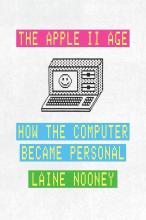
by Laine Nooney
UNIVERSITY OF CHICAGO PRESS, 2023, 352 PP. HARDCOVER, $28.00
ISBN: 978-0-226-81653-1
Apple and Atari, which themselves were inspired by the countercultural ethos of the Homebrew Computer Club (as documented in books such as Fred Turner’s From Counterculture to Cyberculture and John Markoff ’s What the Dormouse Said), so while these companies were not completely unrelated, the ideological distance between them points to the flexible nature of the phrase, which was used in both garages and corporate offices and in the domestic sphere with the computer’s rising popularity in middle-class homes.1 Through its introduction into these spaces, the computer took on new meaning as a cultural technology, one that could provide tangible benefits to the lives of ordinary people in ways that were far removed from the university research and military-industrial complex from which the American computer industry initially emerged.
In this way, The Apple II Age is a sociocultural history specifically indebted to the academic tradition of cultural studies, and it’s through Nooney’s emphasis on software that [End Page 100] the cultural dimensions of the Apple II take shape. Following an introduction and two chapters on the origins of the Apple II (“Prehistories of the Personal” and “Cultivating the Apple II”), each of the remaining five chapters highlights an individual software application in an effort to demonstrate the cultural penetration of the Apple II, as well as its “technical, social, and economic context” (15). From engineers’ early use of the Apple II’s new hardware capabilities with the printer and floppy drive (chapter 6, “Home: The Print Shop” and chapter 5, “Utilities: Locksmith”) to the machines’ expansion into uncharted frontiers for desktop computing in the office, the classroom, and the entertainment center (chapter 3, “Business: VisiCalc,” chapter 4, “Games: Mystery House,” and chapter 7, “Education: Snooper Troops”), Nooney shows how the computer was reimagined as a sprightly companion to daily life, more like a radio or calculator with its accessible price point and endless potential for customization than any vacuum-tube computer system of the era. “Hobbyists desired not just access to computing power in the general sense, but a computer appropriate to a context of use solely defined by its owner,” Nooney writes (34). These users “had always owned their kits and radios and calculators, so why should a computer be any different?” (34).
The book’s early chapters trace the technical developments in time-sharing and general-purpose logic chip development that made microcomputers like the Apple II possible to begin with. This materialist bent, however, eventually gives way to a sociocultural emphasis on the people responsible for building the software denoted by each chapter, the publishing companies that helped them introduce this software to the public, and the relationships between these parties that ultimately cemented their places in computing history. Nooney introduces readers to Dan Bricklin and Bob Frankston, two MIT-educated programmers who, with help from Harvard MBA Dan Fylstra, turned a small piece of third-party software called VisiCalc into the “killer app” for the Apple II, which in turn helped popularize the spreadsheet as an organizational and epistemological form (73). Their relationship is one of many that the author uses to show how reliant the software industry of the period was on publishing companies such as Fylstra’s Personal Software (later rebranded as VisiCorp) to bring their products to market. With software engineering still largely in its infancy as a full-time occupation, the vast majority of the software mentioned in Nooney’s text was notably produced by developers from many different backgrounds and experience levels, and it’s often their relationships with publishers that allowed them to find a substantial audience for their software. Snooper Troops creator Tom Snyder was a Cambridge, Massachusetts, middle school teacher before reconnecting with his teenage passion for kit-based computing and—in part thanks to a publishing partnership with the father of one of his students, who in turn connected him with the entertainment conglomerate McGraw-Hill—producing one of the Apple II’s most successful educational games.
Snyder’s story demonstrates how much of Nooney’s narrative emerges from a specific moment in geospatial history that clearly favors cisgender white men who were born into well-off households, who were raised in one of the richest countries in the world, and who came of age during the precise moment when desktop computing seemed fated to change history. Yet Nooney repeatedly pushes back against this tide of “great men, with their great technologies, launching their great revolutions,” highlighting the contributions of women and queer people to computing history writ large (5). For every person like Steve Jobs, Steve Wozniak, or Mike Markkula, there’s someone like Roberta Williams, the writer and game designer whose pitch for an “Agatha Christie–style domestic horror” [End Page 101] called Mystery House evolved into one of the Apple II’s best-selling games (112), or David Balsam and Martin Kahn, the gay couple responsible for turning the Apple II into a graphic design machine with The Print Shop. While it’s difficult to completely separate the nested histories of the Apple II and the microcomputer from computing’s reputation as a predominantly “white, male interest,” Nooney offers a compelling counterhistory that moves in tandem with this normative chronology, showcasing the lesser-known figures at the center of what’s still ultimately a success story for practically everyone involved (31). If the victors of history are the brands and machines we still encounter today, The Apple II Age shows that this history stretches far and wide in perpetually surprising ways.
—Rob Arcand, Mcgill University
- Fred Turner, From Counterculture to Cyberculture: Stewart Brand, the Whole Earth Network, and the Rise of Digital Utopianism (Chicago: University of Chicago Press, 2004); John Markoff, What the Dormouse Said: How the Sixties Counterculture Shaped the Personal Computer Industry (New York: Penguin, 2005).

